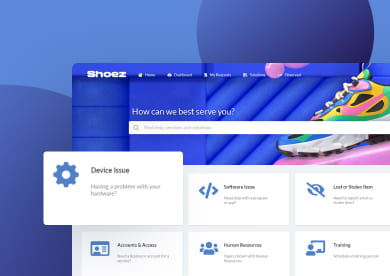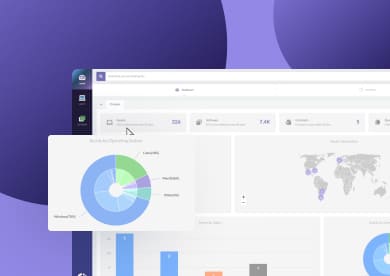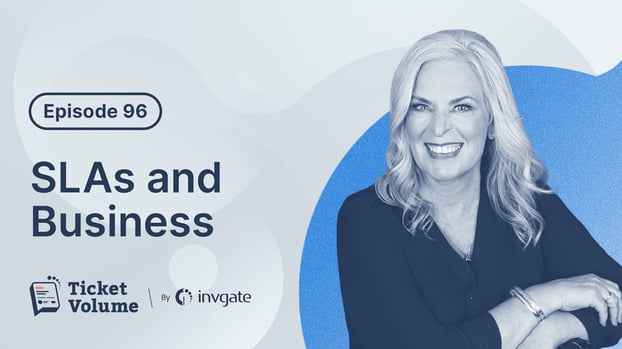In the IT Service Management (ITSM) world, there’s one topic that can spark excitement and anxiety in equal measure: Service Level Agreements (SLAs). For some, SLAs are a safety net ensuring everything runs smoothly; for others, they’re a looming specter of deadlines and metrics. So, how can we reframe SLAs as a tool for collaboration and success rather than a weapon of pressure? That’s exactly what Linda Lenox breaks down in Episode 96 of Ticket Volume - IT Podcast.
In this episode host Matt Beran sits down with Linda, a tech powerhouse who has led service desk transformations at some major organizations, including The New York Times, Cox Communications, and Curo Financial Group. With her signature blend of wit and wisdom, she discusses the good, the bad, and the surprisingly effective side of SLAs—and why service desk analysts shouldn’t fear them.
Linda dives into the key role SLAs play in aligning IT with business needs, how they can drive meaningful improvements (when used correctly), and the common pitfalls teams face when SLAs are mishandled. Hint: if your service desk agents are more worried about hitting metrics than solving problems, you might have a stick-versus-carrot situation on your hands.
Ready to transform the way you think about SLAs? Let’s dive into the highlights!

The art of designing effective SLAs
Creating an SLA isn’t just about picking numbers and hoping for the best. The process should start by understanding your current state: where are you today, and where do you need to be?
Instead of jumping straight to rigid targets, it’s important to use a broad range of metrics that reflect quality, not just speed. After all, what good is answering every call within three rings if agents are rushing customers off the phone or missing key details?
Effective SLAs require a balance of science (metrics and data) and art (understanding what those numbers mean for business outcomes).
Moving beyond the fear of metrics
For many service desk analysts, SLAs feel like a trap rather than a target. Fear typically comes from poor implementation. When SLAs are used as a stick to punish agents, the result is a team that gamifies metrics to avoid getting in trouble.
“SLAs are not meant to be weapons. If you’re punishing analysts for missing targets, they’ll find ways to game the system—and that’s when you lose sight of the bigger picture.”

Linda Lenox,
Senior Technology Operations LeaderA collaborative approach is key, where SLAs act as guidelines for continuous improvement rather than rigid mandates. This means involving analysts in the process and ensuring they understand the business needs behind each target.
When SLAs are seen as collaborative agreements rather than punishments, they can help teams grow and improve.
Real-life example: The power of temporary SLAs
A real-world example demonstrates how temporary SLAs can address immediate problems. Initially, only 3% of new hires at Linda’s organization had their equipment and accounts ready on day one. To fix this, temporary SLAs, dashboards, and automated alerts were set up, ensuring corrective actions before new hires arrived.
This approach resulted in a 95% success rate in meeting onboarding requirements. Temporary and flexible SLAs can solve specific problems without becoming a permanent burden.
The role of SLAs in continuous improvement
Missed SLAs should be seen as learning opportunities rather than reasons for blame. When SLAs are missed, teams should focus on understanding the root cause—whether it’s a staffing issue, a process bottleneck, or an unforeseen surge in demand.
“You can’t fix what you don’t understand. When SLAs are missed, it’s not about making excuses—it’s about identifying the why and addressing the root cause.”

Linda Lenox,
Senior Technology Operations LeaderBy identifying these causes, organizations can implement corrective actions to prevent future issues. This approach turns SLAs into a mechanism for continuous service improvement.
Rigid SLAs that discourage creativity can harm morale and service quality. Instead, missed SLAs should prompt conversations that lead to improvement rather than finger-pointing.
Customization and collaboration: The secret to SLA success
There’s no one-size-fits-all approach to SLAs. Tailoring them to fit the unique needs of each business is crucial. For example, a company focused on first-call resolution may have different targets than one prioritizing speed.
Granular scorecards that provide individual metrics for agents can help identify standout performers and areas for improvement. Engaging both IT and business stakeholders ensures SLAs reflect real needs rather than arbitrary targets.
Regular reviews are essential, as evolving business requirements necessitate updates to keep SLAs relevant and effective.
Automation as a safety net for SLAs
Automation plays a vital role in ensuring SLAs are met. Automated alerts, automated dashboards, and automated workflows allow teams to catch potential issues early and address them before they escalate.
By leveraging automation, organizations can ensure smoother operations and avoid unnecessary SLA violations, ultimately improving service quality.
Conclusion: SLAs as a bridge, not a barrier
When used correctly, SLAs align IT with business goals, drive improvements, and foster collaboration. They should act as a bridge between teams—not a barrier that divides them.
By focusing on customization, continuous improvement, collaboration, and leveraging automation, organizations can transform SLAs from dreaded obligations into valuable assets. Let’s use them to learn, improve, and deliver better service. So, take a cue from Linda and start viewing your SLAs as the key to better service—not just another box to check.
Want to hear more of Linda’s insights? Catch the full episode of Ticket Volume on your favorite podcast platform and discover how to make SLAs work for you. You can find the full episode on Apple Podcasts, Spotify, YouTube, or your favorite podcast platform.















